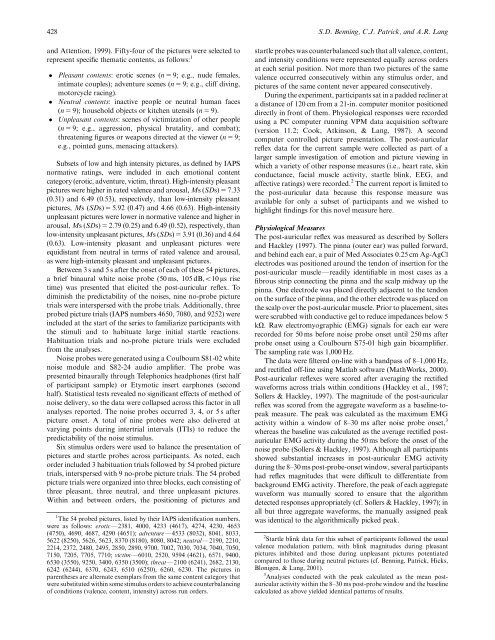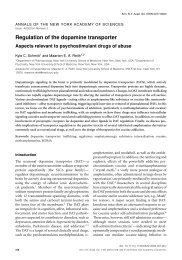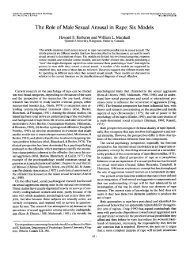Emotional modulation of the postauricular reflex
Emotional modulation of the postauricular reflex
Emotional modulation of the postauricular reflex
You also want an ePaper? Increase the reach of your titles
YUMPU automatically turns print PDFs into web optimized ePapers that Google loves.
428 S.D. Benning, C.J. Patrick, and A.R. Lang<br />
and Attention, 1999). Fifty-four <strong>of</strong> <strong>the</strong> pictures were selected to<br />
represent specific <strong>the</strong>matic contents, as follows: 1<br />
Pleasant contents: erotic scenes (n 5 9; e.g., nude females,<br />
intimate couples); adventure scenes (n 5 9; e.g., cliff diving,<br />
motorcycle racing).<br />
Neutral contents: inactive people or neutral human faces<br />
(n 5 9); household objects or kitchen utensils (n 5 9).<br />
Unpleasant contents: scenes <strong>of</strong> victimization <strong>of</strong> o<strong>the</strong>r people<br />
(n 5 9; e.g., aggression, physical brutality, and combat);<br />
threatening figures or weapons directed at <strong>the</strong> viewer (n 5 9;<br />
e.g., pointed guns, menacing attackers).<br />
Subsets <strong>of</strong> low and high intensity pictures, as defined by IAPS<br />
normative ratings, were included in each emotional content<br />
category (erotic, adventure, victim, threat). High-intensity pleasant<br />
pictures were higher in rated valence and arousal, Ms(SDs) 5 7.33<br />
(0.31) and 6.49 (0.53), respectively, than low-intensity pleasant<br />
pictures, Ms (SDs) 5 5.92 (0.47) and 4.66 (0.63). High-intensity<br />
unpleasant pictures were lower in normative valence and higher in<br />
arousal, Ms(SDs) 5 2.79 (0.25) and 6.49 (0.52), respectively, than<br />
low-intensity unpleasant pictures, Ms(SDs) 5 3.91 (0.36) and 4.64<br />
(0.63). Low-intensity pleasant and unpleasant pictures were<br />
equidistant from neutral in terms <strong>of</strong> rated valence and arousal,<br />
as were high-intensity pleasant and unpleasant pictures.<br />
Between 3 s and 5 s after <strong>the</strong> onset <strong>of</strong> each <strong>of</strong> <strong>the</strong>se 54 pictures,<br />
a brief binaural white noise probe (50 ms, 105 dB,o10 ms rise<br />
time) was presented that elicited <strong>the</strong> post-auricular <strong>reflex</strong>. To<br />
diminish <strong>the</strong> predictability <strong>of</strong> <strong>the</strong> noises, nine no-probe picture<br />
trials were interspersed with <strong>the</strong> probe trials. Additionally, three<br />
probed picture trials (IAPS numbers 4650, 7080, and 9252) were<br />
included at <strong>the</strong> start <strong>of</strong> <strong>the</strong> series to familiarize participants with<br />
<strong>the</strong> stimuli and to habituate large initial startle reactions.<br />
Habituation trials and no-probe picture trials were excluded<br />
from <strong>the</strong> analyses.<br />
Noise probes were generated using a Coulbourn S81-02 white<br />
noise module and S82-24 audio amplifier. The probe was<br />
presented binaurally through Telephonics headphones (first half<br />
<strong>of</strong> participant sample) or Etymotic insert earphones (second<br />
half). Statistical tests revealed no significant effects <strong>of</strong> method <strong>of</strong><br />
noise delivery, so <strong>the</strong> data were collapsed across this factor in all<br />
analyses reported. The noise probes occurred 3, 4, or 5 s after<br />
picture onset. A total <strong>of</strong> nine probes were also delivered at<br />
varying points during intertrial intervals (ITIs) to reduce <strong>the</strong><br />
predictability <strong>of</strong> <strong>the</strong> noise stimulus.<br />
Six stimulus orders were used to balance <strong>the</strong> presentation <strong>of</strong><br />
pictures and startle probes across participants. As noted, each<br />
order included 3 habituation trials followed by 54 probed picture<br />
trials, interspersed with 9 no-probe picture trials. The 54 probed<br />
picture trials were organized into three blocks, each consisting <strong>of</strong><br />
three pleasant, three neutral, and three unpleasant pictures.<br />
Within and between orders, <strong>the</strong> positioning <strong>of</strong> pictures and<br />
1 The 54 probed pictures, listed by <strong>the</strong>ir IAPS identification numbers,<br />
were as follows: eroticF2381, 4000, 4233 (4617), 4274, 4230, 4653<br />
(4750), 4690, 4687, 4290 (4651); adventureF4533 (8032), 8041, 8033,<br />
5622 (8250), 5626, 5623, 8370 (8180), 8080, 8042; neutralF2190, 2210,<br />
2214, 2372, 2480, 2495, 2850, 2890, 9700, 7002, 7030, 7034, 7040, 7050,<br />
7150, 7205, 7705, 7710; victimF6010, 2520, 9594 (4621), 6571, 9400,<br />
6530 (3550), 9250, 3400, 6350 (3500); threatF2100 (6241), 2682, 2130,<br />
6242 (6244), 6370, 6243, 6510 (6250), 6260, 6230. The pictures in<br />
paren<strong>the</strong>ses are alternate exemplars from <strong>the</strong> same content category that<br />
were substituted within some stimulus orders to achieve counterbalancing<br />
<strong>of</strong> conditions (valence, content, intensity) across run orders.<br />
startle probes was counterbalanced such that all valence, content,<br />
and intensity conditions were represented equally across orders<br />
at each serial position. Not more than two pictures <strong>of</strong> <strong>the</strong> same<br />
valence occurred consecutively within any stimulus order, and<br />
pictures <strong>of</strong> <strong>the</strong> same content never appeared consecutively.<br />
During <strong>the</strong> experiment, participants sat in a padded recliner at<br />
a distance <strong>of</strong> 120 cm from a 21-in. computer monitor positioned<br />
directly in front <strong>of</strong> <strong>the</strong>m. Physiological responses were recorded<br />
using a PC computer running VPM data acquisition s<strong>of</strong>tware<br />
(version 11.2; Cook, Atkinson, & Lang, 1987). A second<br />
computer controlled picture presentation. The post-auricular<br />
<strong>reflex</strong> data for <strong>the</strong> current sample were collected as part <strong>of</strong> a<br />
larger sample investigation <strong>of</strong> emotion and picture viewing in<br />
which a variety <strong>of</strong> o<strong>the</strong>r response measures (i.e., heart rate, skin<br />
conductance, facial muscle activity, startle blink, EEG, and<br />
affective ratings) were recorded. 2 The current report is limited to<br />
<strong>the</strong> post-auricular data because this response measure was<br />
available for only a subset <strong>of</strong> participants and we wished to<br />
highlight findings for this novel measure here.<br />
Physiological Measures<br />
The post-auricular <strong>reflex</strong> was measured as described by Sollers<br />
and Hackley (1997). The pinna (outer ear) was pulled forward,<br />
and behind each ear, a pair <strong>of</strong> Med Associates 0.25 cm Ag-AgCl<br />
electrodes was positioned around <strong>the</strong> tendon <strong>of</strong> insertion for <strong>the</strong><br />
post-auricular muscleFreadily identifiable in most cases as a<br />
fibrous strip connecting <strong>the</strong> pinna and <strong>the</strong> scalp midway up <strong>the</strong><br />
pinna. One electrode was placed directly adjacent to <strong>the</strong> tendon<br />
on <strong>the</strong> surface <strong>of</strong> <strong>the</strong> pinna, and <strong>the</strong> o<strong>the</strong>r electrode was placed on<br />
<strong>the</strong> scalp over <strong>the</strong> post-auricular muscle. Prior to placement, sites<br />
were scrubbed with conductive gel to reduce impedances below 5<br />
kO. Raw electromyographic (EMG) signals for each ear were<br />
recorded for 50 ms before noise probe onset until 250 ms after<br />
probe onset using a Coulbourn S75-01 high gain bioamplifier.<br />
The sampling rate was 1,000 Hz.<br />
The data were filtered on-line with a bandpass <strong>of</strong> 8–1,000 Hz,<br />
and rectified <strong>of</strong>f-line using Matlab s<strong>of</strong>tware (MathWorks, 2000).<br />
Post-auricular <strong>reflex</strong>es were scored after averaging <strong>the</strong> rectified<br />
waveformsacrosstrialswithinconditions(Hackleyetal.,1987;<br />
Sollers & Hackley, 1997). The magnitude <strong>of</strong> <strong>the</strong> post-auricular<br />
<strong>reflex</strong> was scored from <strong>the</strong> aggregate waveform as a baseline-topeak<br />
measure. The peak was calculated as <strong>the</strong> maximum EMG<br />
activity within a window <strong>of</strong> 8–30 ms after noise probe onset, 3<br />
whereas <strong>the</strong> baseline was calculated as <strong>the</strong> average rectified <strong>postauricular</strong><br />
EMG activity during <strong>the</strong> 50 ms before <strong>the</strong> onset <strong>of</strong> <strong>the</strong><br />
noise probe (Sollers & Hackley, 1997). Although all participants<br />
showed substantial increases in post-auricular EMG activity<br />
during <strong>the</strong> 8–30 ms post-probe-onset window, several participants<br />
had <strong>reflex</strong> magnitudes that were difficult to differentiate from<br />
background EMG activity. Therefore, <strong>the</strong> peak <strong>of</strong> each aggregate<br />
waveform was manually scored to ensure that <strong>the</strong> algorithm<br />
detected responses appropriately (cf. Sollers & Hackley, 1997); in<br />
all but three aggregate waveforms, <strong>the</strong> manually assigned peak<br />
was identical to <strong>the</strong> algorithmically picked peak.<br />
2 Startle blink data for this subset <strong>of</strong> participants followed <strong>the</strong> usual<br />
valence <strong>modulation</strong> pattern, with blink magnitudes during pleasant<br />
pictures inhibited and those during unpleasant pictures potentiated<br />
compared to those during neutral pictures (cf. Benning, Patrick, Hicks,<br />
Blonigen, & Lang, 2001).<br />
3 Analyses conducted with <strong>the</strong> peak calculated as <strong>the</strong> mean <strong>postauricular</strong><br />
activity within <strong>the</strong> 8–30 ms post-probe window and <strong>the</strong> baseline<br />
calculated as above yielded identical patterns <strong>of</strong> results.










